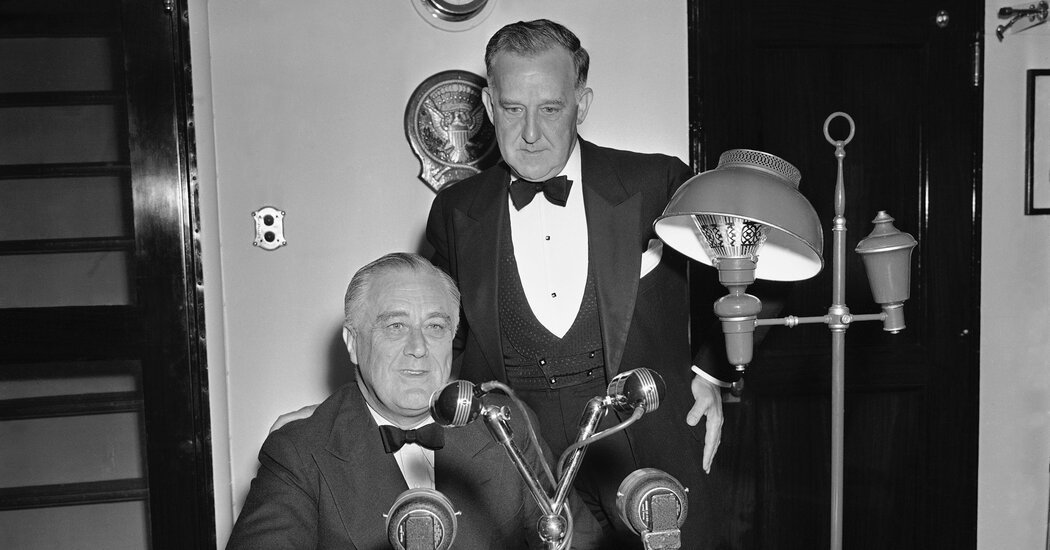[ad_1]
A federal judge has made a decision in a dispute between relatives of Franklin D. Roosevelt’s press secretary over ownership of four Norman Rockwell drawings that hung for decades in the White House.
The drawings — titled “So You Want to See the President!” — show a range of figures, including a Scottish military officer, a beauty pageant winner and a U.S. senator, all waiting at the White House for an audience with Roosevelt. Rockwell gave the originals of the drawings, which were published in The Saturday Evening Post, to the president’s press secretary, Stephen T. Early. One drawing depicts Early with a pipe clenched between his teeth, facing a clutch of reporters.
The four panels of illustrations, created in 1943, were annotated when they appeared in The Post as part of a humorous look at the broad variety of people who sought Oval Office meetings during wartime.
The court case focused on who in the family had inherited the drawings from Early, with some relatives saying that they had been unaware until recently that the works had been on loan to the White House since 1978.
Relatives of Thomas A. Early, a son of the former press secretary, said in court papers that he had only learned that the drawings had left a family homestead when, in 2017, he watched President Donald J. Trump being interviewed on television. There, in the background, were the Rockwells.
Mr. Early wrote to the White House saying he suspected the works had been lent without his permission by his nephew, William Nile Elam III.
Years of legal filings and bitter disputes followed, pitting cousin against cousin, with each side accusing the other of bad faith and skulduggery.
Several members of the Early family argued that they were part owners of the drawings, which the White House curator wrote in 2017 had been valued at about $8 million as part of “an unofficial appraisal” by people at a major auction house.
But Mr. Elam countered that he alone owned the drawings, adding that his grandfather, the press secretary, had given the works to his daughter Helen Early Elam, Mr. Elam’s mother.
His ownership claim was upheld by Judge Michael S. Nachmanoff, of Federal District Court in Alexandria, Va., who issued a written opinion on Tuesday that embraced the aesthetic context of the quarrel. In making his ruling, the judge quoted from the short story “Babylon Revisited,” published in 1931 by The Saturday Evening Post, a publication in which Rockwell’s images routinely appeared.
The judge wrote: “F. Scott Fitzgerald once opined, ‘family quarrels are bitter things. They don’t go according to any rules.’” He added that the property rules in this case, however, “lead to a clear outcome.”
Judge Nachmanoff decided in Mr. Elam’s favor based, in part, on evidence that he said showed that the drawings had been in the physical possession of either Mr. Elam or his mother for a long period of time, 18 years, before they had gone to the White House.
Robert Goldman, a lawyer for the members of the Early family who had opposed Mr. Elam in court, said by email that he was consulting with his clients about appealing the judge’s order declaring Mr. Elam the sole owner of the illustrations.
In one legal filing, Mr. Elam traced the ownership trail of the Rockwells that started, he said, with a gift in 1949. That year, according to Mr. Elam, Mr. Early gave the works to his daughter Helen, who had just graduated from the Pratt Institute in Brooklyn, where she had studied advertising design. Mr. Early died two years later.
The Early family members provided an entirely different account of what had happened to the Rockwells. They argued that the illustrations were a family heirloom, long in the possession of Mr. Early’s wife and jointly owned by family members after her death in 1978. They said Helen had asked her brother Thomas for permission to exhibit the Rockwells in San Francisco in 1980, evidence that they suggested showed that she knew she was not the sole owner.
The parties agreed that after Mrs. Early died, her grandson, Mr. Elam, had taken the drawings to the White House. The Early family members said those works had been placed on loan with the lender listed as anonymous, which they argued was part of a scheme by Mr. Elam to make it easier for him to assume sole ownership.
Two of Mr. Elam’s lawyers, David G. Fiske and Thomas C. Junker, said they were unaware of any evidence that their client had asked the White House to conceal the identity of the lender. They added that the White House loan had followed an attempted break-in at the home of Mr. Elam’s grandmother, Helen Wrenn Early, in Virginia. One of Mr. Elam’s lawyers also said that members of the Early family had been aware that the paintings were on display in the White House, notwithstanding what Thomas A. Early was said to have thought.
Judge Nachmanoff wrote that either Mr. Elam or his mother had physical possession of the illustrations from 1960 to 1978, meaning that Mr. Elam was “entitled to the benefit of the common law presumption of ownership based on that possession.”
Although members of the Early family had tried to rebut that presumption by advancing a “theory of theft” by Mr. Elam, the judge added in his opinion that they had not provided “the kind or quantity of evidence to establish theft.”
Before the drawings were returned to Mr. Elam last year, they had hung in the White House during eight presidential administrations, starting with Jimmy Carter’s.
Mr. Fiske, the lawyer, said that Mr. Elam was happy to have them back.
“They’ve been part of his life for a long time,” Mr. Fiske said, adding of Mr. Elam, “He feels vindicated.”
[ad_2]
